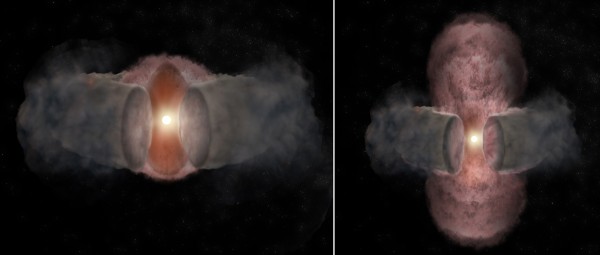[PHOTO] Astronomers Watch Stunning, Massive Protostar Formation in Real Time
| Ana Verayo | | Apr 03, 2015 04:14 AM EDT |
(Photo : Bill Saxton, NRAO/AUI/NSF) Artist's conception of the development of W75N(B)-VLA-2. At left, a hot wind from the young star expands nearly spherically, as seen in 1996. At right, as seen in 2014, the hot wind has been shaped by encountering a dusty, donut-shaped torus around the star and appears elongated.
Astronomers have witnessed star formation as it occurred in a massive protostar some 4,200 light years from Earth.
The star called the W75N(B)-VLA 2 is currently undergoing a chaotic evolution. In a span of just 18 years, the protostar is shown in a pair of images from the beginning and the end of this brief cosmic event.
Like Us on Facebook
Radio telescopes first detected a cloud in 1996 in the region called W75N(B), which is apparently a star forming region. The cloud had no structure at first and also had a directionless magnetic field. Solar winds tossed the cloud in every possible direction.
Astronomers, however, said observations from last year revealed these stellar winds have begun to align with the cloud's poles and the magnetic field around it is now aligned around the cloud of dust and gas.
These are certainly remarkable, said Carlos Carrasco-Gonzalez from the Center of Radioastronomy and Astrophysics of the National Autonomous University of Mexico. The dramatic change was seen in real time and means this object provides an exciting opportunity to observe how a very young star evolves in its early stages of formation.
The images of the star's development were obtained using the Very Large Array Telescope of the National Science Foundation, some 50 miles west of Socorro, New Mexico.
During this rapid, turbulent evolution of the young star, the environment was made up of dense hot clouds of dust and gas, surrounded by a ring of dust called torus.
Apart from that, the protostar had hot ionized winds ejected by the star during a repetitive process, expanding the cloud equally in every direction and resulting in a spherical shell around the star.
Scientists believe when the solar winds hit the dust torus, the winds traveled slower. The torus' magnetic poles, however, have less resistance and shifted more quickly. That's why the spherical shell surrounding the star has an elongated shape stretching outwards.
Working with an international team from Korea, Japan, Mexico, Spain, Sweden and the Netherlands, Carrasco-Gonzales says they've predicted this in just a span of 18 years. Scientists now estimate W75N(B)-VLA 2 is eight times more massive than the Sun.
This study was published in the journal, Science.
TagsW75N(B)-VLA 2, massive star formation growth images, protostar, [PHOTO] Astronomers Watch Stunning Young Star Formation in Real Time
©2015 Chinatopix All rights reserved. Do not reproduce without permission
EDITOR'S PICKS
-

Did the Trump administration just announce plans for a trade war with ‘hostile’ China and Russia?
-

US Senate passes Taiwan travel bill slammed by China
-

As Yan Sihong’s family grieves, here are other Chinese students who went missing abroad. Some have never been found
-

Beijing blasts Western critics who ‘smear China’ with the term sharp power
-

China Envoy Seeks to Defuse Tensions With U.S. as a Trade War Brews
-

Singapore's Deputy PM Provides Bitcoin Vote of Confidence Amid China's Blanket Bans
-

China warns investors over risks in overseas virtual currency trading
-

Chinese government most trustworthy: survey
-

Kashima Antlers On Course For Back-To-Back Titles
MOST POPULAR
LATEST NEWS
Zhou Yongkang: China's Former Security Chief Sentenced to Life in Prison

China's former Chief of the Ministry of Public Security, Zhou Yongkang, has been given a life sentence after he was found guilty of abusing his office, bribery and deliberately ... Full Article
TRENDING STORY

China Pork Prices Expected to Stabilize As The Supplies Recover

Elephone P9000 Smartphone is now on Sale on Amazon India

There's a Big Chance Cliffhangers Won't Still Be Resolved When Grey's Anatomy Season 13 Returns

Supreme Court Ruled on Samsung vs Apple Dispute for Patent Infringement

Microsoft Surface Pro 5 Rumors and Release Date: What is the Latest?










